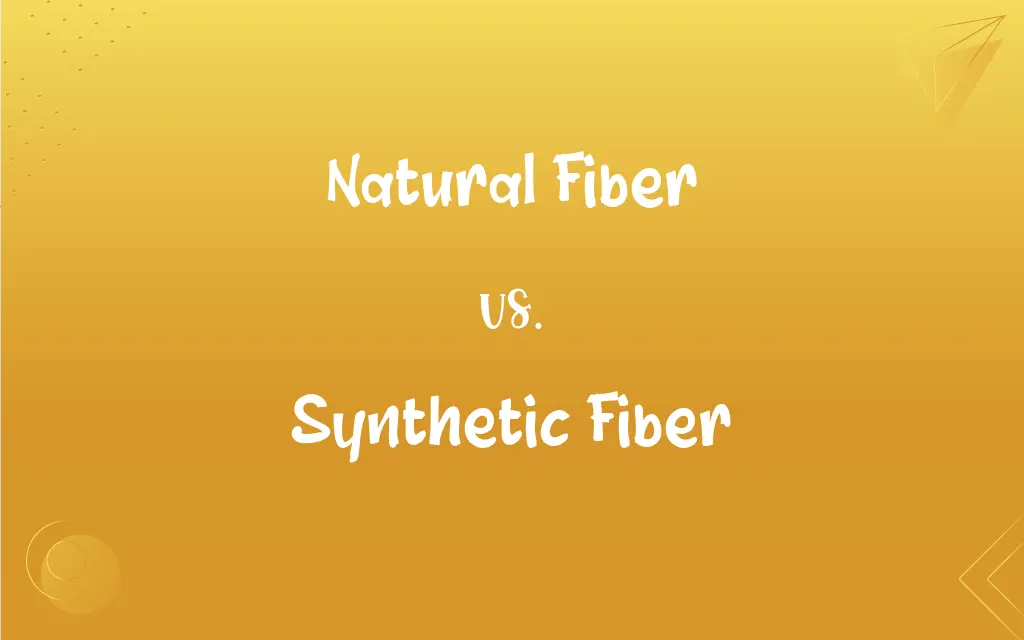Natural Fiber vs. Synthetic Fiber: What's the Difference?
Edited by Aimie Carlson || By Harlon Moss || Updated on October 19, 2023
Natural fiber originates from plants, animals, or minerals, while synthetic fiber is man-made, typically from petrochemicals.

Key Differences
Natural fiber and synthetic fiber differ primarily in their origins. Natural fibers are derived directly from the natural world, be it from plants, animals, or minerals. On the other hand, synthetic fibers are man-made and are typically developed through chemical processes.
Many natural fibers, such as cotton, wool, or silk, have been used for thousands of years to produce clothing and textiles. These fibers, being of natural origin, tend to be biodegradable. Conversely, synthetic fibers, like polyester or nylon, are a relatively recent invention and are products of the modern chemical industry.
The properties of natural fiber and synthetic fiber can vary significantly. Natural fibers often offer comfort, breathability, and a more organic feel, making them preferred for certain garments. Synthetic fibers, however, tend to be more durable, resistant to certain elements, and can be engineered for specific uses.
In terms of environmental impact, natural fiber, being biodegradable, might seem more eco-friendly. However, some natural fiber cultivation, like cotton, can be resource-intensive. Synthetic fibers, being petroleum-based, can contribute to environmental pollution but are also responsible for innovative, lightweight materials with specialized uses.
When choosing between natural fiber and synthetic fiber in products, it often comes down to the desired characteristics of the end product. A blend of both types can sometimes offer the benefits of each, providing comfort from the natural component and durability from the synthetic.
ADVERTISEMENT
Comparison Chart
Origin
Derived from plants, animals, minerals.
Man-made, usually from petrochemicals.
Historical Use
Used for millennia (e.g., cotton, wool).
Modern invention (e.g., polyester, nylon).
Properties
Comfort, breathability, organic feel.
Durable, can be engineered for specific uses.
Environmental Impact
Often biodegradable but can be resource-intensive
Non-biodegradable, petroleum-based.
Examples
Cotton, silk, hemp.
Polyester, nylon, acrylic.
ADVERTISEMENT
Natural Fiber and Synthetic Fiber Definitions
Natural Fiber
Raw materials spun into threads for weaving.
Jute, a coarse natural fiber, is commonly used for making bags.
Synthetic Fiber
Fibers created in labs, not directly from nature.
Polyester, a synthetic fiber, is widely used for its durability.
Natural Fiber
Fibers derived from plants, animals, or minerals.
Cotton is a popular natural fiber used in clothing.
Synthetic Fiber
Non-natural fibers derived primarily from petrochemicals.
Spandex, a synthetic fiber, offers exceptional stretchability.
Natural Fiber
Organic materials used in textile production.
Wool, a natural fiber, provides warmth in winter garments.
Synthetic Fiber
Engineered fibers for specific textile properties.
Kevlar, a synthetic fiber, is used in bulletproof vests for its high tensile strength.
Natural Fiber
Fibers that are not manufactured or chemically altered.
Flax is a natural fiber that's been used for centuries.
Synthetic Fiber
Man-made fibers developed through chemical processes.
Nylon, a synthetic fiber, is known for its strength.
Natural Fiber
Biodegradable materials used in fabrics.
Silk, a luxurious natural fiber, is often used for elegant attire.
Synthetic Fiber
Artificial materials designed for textiles.
Acrylic, a synthetic fiber, often mimics the feel of wool.
FAQs
Is cotton a natural or synthetic fiber?
Cotton is a natural fiber.
Why are synthetic fibers popular in sportswear?
Synthetic fibers can be engineered for specific properties like moisture-wicking or durability, making them suitable for sportswear.
What are natural fibers made from?
Natural fibers are derived from plants, animals, or minerals.
Which synthetic fiber is known for its high tensile strength?
Kevlar is a synthetic fiber renowned for its strength.
Are synthetic fibers flammable?
Some synthetic fibers can be flammable, but others are designed to be flame-retardant.
How are synthetic fibers produced?
Synthetic fibers are man-made, usually created through chemical processes using petrochemicals.
Which fiber is more eco-friendly?
Natural fibers are biodegradable, but their cultivation can be resource-intensive. Synthetic fibers are non-biodegradable but have innovative applications.
Which fiber type is more resistant to wrinkles?
Synthetic fibers, like polyester, generally resist wrinkles better than many natural fibers.
Are there blends of natural and synthetic fibers?
Yes, many fabrics blend the two to combine the benefits of each.
Are synthetic fibers recyclable?
Some synthetic fibers can be recycled, depending on their composition and local recycling capabilities.
How long have humans used natural fibers?
For millennia, with examples like wool and silk tracing back thousands of years.
Why might a fabric blend natural and synthetic fibers?
To achieve a balance of comfort from natural fibers and durability or specific properties from synthetics.
Which type of fiber is generally more expensive?
Prices vary, but natural fibers like silk or cashmere can be more costly than many synthetics.
Can natural fibers cause allergies?
Yes, some individuals may be allergic to specific natural fibers like wool.
Can natural fibers be treated to acquire properties of synthetics?
Yes, treatments can enhance properties like water-resistance or durability in natural fibers.
What's a common natural fiber used in ropes?
Hemp is a traditional natural fiber used in ropes.
Which is more breathable, natural or synthetic fiber?
Generally, natural fibers like cotton are more breathable than many synthetics.
Can synthetic fibers mimic natural ones?
Yes, some synthetic fibers are designed to feel and behave like natural fibers.
Do synthetic fibers offer UV protection?
Some synthetic fibers are treated or engineered to offer UV protection.
Are synthetic fibers always derived from petrochemicals?
While many are, there are also bio-based synthetic fibers derived from renewable resources.
About Author
Written by
Harlon MossHarlon is a seasoned quality moderator and accomplished content writer for Difference Wiki. An alumnus of the prestigious University of California, he earned his degree in Computer Science. Leveraging his academic background, Harlon brings a meticulous and informed perspective to his work, ensuring content accuracy and excellence.
Edited by
Aimie CarlsonAimie Carlson, holding a master's degree in English literature, is a fervent English language enthusiast. She lends her writing talents to Difference Wiki, a prominent website that specializes in comparisons, offering readers insightful analyses that both captivate and inform.































































